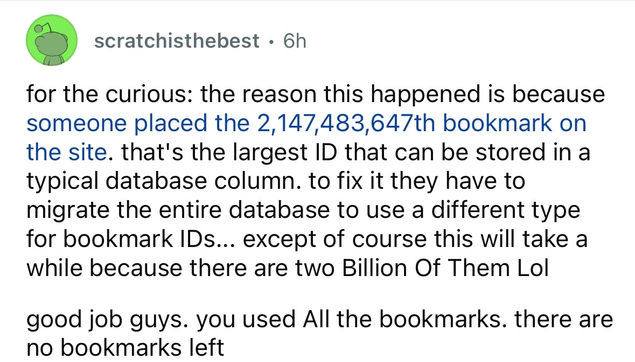@catgirlQueer @vashti As I myself wrote, years ago,
"At nanosecond resolution (if I've done my arithmetic right), 128 bits will represent a span of 1 x 10²² years, or much longer than from the big bang to the estimated date of fuel exhaustion of all stars. So I think I'll arbitrarily set an epoch 14Bn years before the UNIX epoch and go with that. The time will be unsigned - there is no time before the big bang."
So, yes, if you're content with nanosecond resolution...
https://github.com/simon-brooke/post-scarcity/wiki/cons-space#time
@simon_brooke @catgirlQueer @vashti
Fun fact:
Until 1972-01-01Z we used rubber-time, because astrometry is not nearly as constant as most people seem to think.
But it is worse than that.
We literally have no idea how long nanoseconds took before 1958-01-01Z
If you go back before observations of solar eclipses, we even barely know how long days took.
Any epoch before 1972-01-01Z by defintion causes wrong timekeeping.
@bsdphk @catgirlQueer @vashti Rubber time in this sense?
https://medium.com/know-thyself-heal-thyself/jam-karet-rubber-time-6776fba793a
@simon_brooke @catgirlQueer @vashti
No, rubber time in the sense of "I know the two timestamps, but I do know how long time there was/is/will be between them.
Timestamps and time-scales are merely labels we stick on time to the best of our ability, they are not actually time.
@simon_brooke @catgirlQueer @vashti
Ordering is an entirely different issue.
@simon_brooke @catgirlQueer @vashti
What I'm trying to say is that timestamps are conventions, what they mean depends entirely on the convention, and conventions change over time and space.
From 1958 to 1972 the UTC timescale used SI-seconds, but we adjusted the lengths of those SI-seconds to match the erratic rotation of the planet.
So if you define a timescale based on SI-seconds and extend it back in time, what does that mean ?
@simon_brooke @catgirlQueer @vashti
It literally means that the years 1973 and 1967 did not have the same duration.
So what is your timescale measuring ?
The physical duration we barely have measurements to know precisely ?
Or the conventional difference between the timestamps, disregarding physical reality ?
Talking about nanosecond timescales prior to 1958 simply makes no sense.
@bsdphk @catgirlQueer @vashti like any other human measurement, it's arbitrary. Is the kilogram of platinum carefully stored in Paris getting heavier or lighter? Is the new definition, based on Planck's constant, more durable? We're used to measuring with arbitrary scales.
I think.
Don't you?
@simon_brooke @catgirlQueer @vashti
They all important difference is that we could pull the meter or the kilogram out of the vault and measure them as often as we want, with increasingly sophisticated methods.
When measuring time we get only one chance, in real time, to measure the duration of any specific time-interval.
There can be no "do-over", no "try again with a better clock" and no "best out of N".
@simon_brooke @catgirlQueer @vashti
But time is still different, because it is a real-time running accumulation of non-repeatable measurements of duration.






